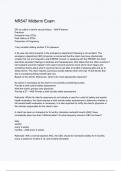NR547
Midterm
Exam
5Ps
to
collect
a
client's
sexual
history:
-
ANS-Partners
Practices Protection
from
STDs
Past
History
of
STDs
Prevention
of
Pregnancy
*may
consider
adding
another
P
for
pleasure
A
52-year-old
client
presents
to
the
emergency
department
following
a
car
accident.
The
emergency
department
(ED)
physician
is
concerned
that
the
client
may
have
intentionally
crashed
her
car
and
requests
a
stat
PMHNP
consult.
In
speaking
with
the
PMHNP,
the
client
describes
persistent
feelings
of
sadness
and
hopelessness.
She
states
that
she
often
wonders
if
her
husband
would
be
happier
if
she
wasn't
around
anymore
since
she's
never
happy
and
sometimes
thinks
about
what
it
would
be
like
to
just
take
a
handful
of
sleeping
pills
and
go
to
sleep
forever.
The
client
reports
a
previous
suicide
attempt
when
she
was
16
but
denies
that
she
is
considering
killing
herself
right
now.
Based
on
the
client's
ASQ
score,
what
is
the
most
appropriate
response?
No
action
is
necessary
as
the
client
is
not
currently
considering
suicide.
Provide
a
brief
suicide
safety
assessment.
Alert
the
client's
primary
care
physician.
Provide
a
ST
-
ANS-Provide
a
brief
suicide
safety
assessment.
Rationale:
While
the
client's
responses
do
not
indicate
a
need
for
a
stat
full
safety
and
mental
health
evaluation,
the
client
requires
a
brief
suicide
safety
assessment
to
determine
whether
a
full
mental
health
evaluation
in
necessary.
It
is
also
important
to
notify
the
client's
physician
or
the
clinician
responsible
for
the
client's
care.
A
client
has
been
on
clozapine
for
9
months.
Absolute
neutrophil
counts
(ANC)
have
consistently
been
less
than
1500/microliter?
At
what
frequency
should
a
CBC
be
drawn?
daily
weekly
every
2
weeks
monthly
-
ANS-every
2
weeks
Rationale:
With
a
normal
baseline
ANC,
the
CBC
should
be
monitored
weekly
for
6
months;
every
2
weeks
for
months
6-12;
and
monthly
thereafter Adjustment
Disorder
with
Anxiety
-
ANS-DSM-5
classifies
adjustment
disorder
as
a
trauma-
and
stressor-related
disorder
-presents
with
nervousness,
worry,
or
jitteriness
-Adjustment
disorder
occurs
in
the
presence
of
a
specific
and
identifiable
stressor
•
common
stressors
include
loss
of
employment,
getting
married,
a
new
disability,
or
a
natural
disaster
•
Symptoms
begin
within
three
months
of
the
stressor
and
typically
last
no
more
than
six
months
Agoraphobia
-
ANS-intense
fear,
anxiety,
or
panic
out
of
proportion
to
the
situation
that
occurs
in
two
or
more
of
the
following
specific
scenarios:
-public
transportation
(bus)
-open
spaces
(parking
lot
or
bridge)
-enclosed
spaces
(store,
theater)
-standing
in
a
crowd
or
line
(crowd)
-being
outside
of
their
home
alogia
-
ANS--decrease
in
speech
or
speech
content
-symptom
of
schizophrenia.
-AKA
poverty
of
speech.
American
Geriatric
Society
(AGS)
Beers
Criteria
-
ANS-Avoid
the
use
of
haloperidol,
ziprasidone,
and
olanzapine
due
to
an
increased
risk
of
CVA,
cognitive
decline,
and
death
in
persons
with
dementia
and
with
dementia-related
psychosis.
anhedonia
-
ANS-inability
to
experience
pleasure
anosognosia
-
ANS-inability
to
realize
that
he
or
she
is
ill,
which
is
caused
by
the
illness
itself.
Antipsychotics:
Potency
low
to
high
-
ANS-Chlorpromazine
-
Low
Mesoridazine
-
Low
Thioridazine
-
Low
Thiothixene
-
Medium
Fluphenazine
-
Medium
Haloperidol
-
High
Anxiety
Disorders
-
ANS-Generalized
Anxiety
Disorder
(GAD)
Social
Anxiety
Disorder
Panic
Phobias
Agoraphobia
Adjustment
Disorder
with
Anxiety Anxiety
is
often
comorbid
with
_________________
as
well
as
medical
conditions
such
as
____________,
___________,
and
___________
-
ANS-major
depression,
COPD,
asthma,
diabetes
Anxiety
rating
scale:
GAD-7
-
ANS-General
Anxiety
Disorder-7
-answer
question
with
several
days
(+1),
more
than
half
days
(+2),
nearly
every
day
(+3)
•
Feeling
nervous,
anxious,
or
on
edge
•
Not
being
able
to
stop
or
control
worrying
•
Worrying
too
much
about
different
things
•
Trouble
relaxing
•
Being
so
restless
that
it's
hard
to
sit
still
•
Becoming
easily
annoyed
or
irritable
•
Feeling
afraid
as
if
something
awful
might
happen
0-4:
No
anxiety
disorder
5-9:
Mild
anxiety
disorder
10-14:
Moderate
anxiety
disorder
15-21:
Severe
anxiety
disorder
Anxiety
rating
scale:
HAM-A
-
ANS-Hamilton
Anxiety
Scale
-mild
(+1),
moderate
(+2),
severe
(+3),
very
severe
(+4)
•
Anxious
mood
•
Tension
•
Fears
•
Insomnia
•
Intellectual
•
Depressed
mood
•
Somatic
(muscular)
•
Somatic
(sensory)
•
Cardiovascular
symptoms
•
Respiratory
symptoms
•
Gastrointestinal
symptoms
•
Genitourinary
symptoms
•
Autonomic
symptoms
•
Behavior
at
interview
0-17:
Mild
anxiety
18-24:
Mild
to
moderate
anxiety
25-30:
Moderate
to
severe
anxiety
31-56:
Severe
anxiety
armodafinil
(Nuvigil)
-
ANS-FDA
Indications:
-excessive
sleepiness
(OSA,
narcolepsy,
shift-work) RX
Status:
Schedule
IV
Normal
Dosage:
150-250
mg/daily
avolition
-
ANS-lack
of
motivation
Basic
Laboratory
Interpretation
-
ANS-Complete
Blood
Count
Comprehensive
Metabolic
Panel
(CMP)
Thyroid
Function
Tests
Vitamin
B12
Level
Vitamin
D
Level
Toxicology
Screen
Urinalysis
(UA)
Basic
Laboratory
Interpretation:
Complete
Blood
Count
-
ANS--measures
RBCs,
WBCs,
hemoglobin,
hematocrit,
and
platelets
-includes
a
differential
of
the
WBCs
-In
mental
health,
the
CBC
is
used
to
rule
out
medical
conditions
that
may
present
with
symptoms
that
can
be
attributed
to
both
medical
and
psychiatric
diagnoses
•
Ex:
rule
out
anemia
as
a
cause
for
depressive
symptoms
and
fatigue
•
Ex:
rule
out
infection
as
a
cause
of
acute
mental
status
changes
RBCs:
4.5-6.0
million/microliter
Hemoglobin:
12-18
grams/100
mL
Hematocrit:
38%-48%
Reticulocytes:
0%-1.5%
WBCs
(total):
5000-10,000/microliter
Neutrophils:
55%-70%
Eosinophils:
1%-3%
Basophils:
0.5%-1%
Lymphocytes:
20%-35%
Monocytes:
3%-8%
Platelets:
150,000-300,000/microliter
Basic
Laboratory
Interpretation:
Comprehensive
Metabolic
Panel
(CMP)
-
ANS-common
blood
test
used
to
determine
general
health
status
-fluid
and
electrolyte
balance,
status
of
the
body's
metabolism,
liver
function,
and
kidney
function
-used
to
monitor
the
effects
of
medications,
such
as
antipsychotics,
on
liver
function
and
glucose
levels
-rule
out
medical
conditions
that
could
cause
symptoms
•
Ex:
changes
in
mood
or
cognition
Sodium
(Na+):
136-145
mEq/L




